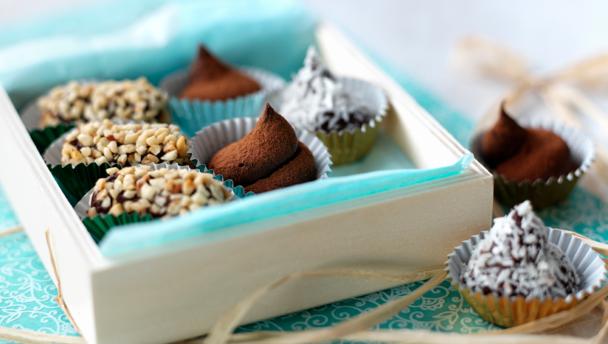

By Chantal Coady
Confectionery describes a broad variety of small, sugar-based delicacies that are usually eaten with the fingers and keep for a long time. In Western Europe and North America, confectionery largely refers to sweets and chocolate bars, but the range of confectionery found around the world is vast, from Indian sweetmeats (such as burfi, halva and jalebi) to Middle Eastern Turkish delight and baklava and Chinese candied fruits. Many confectionery items are related to festivals and celebrations in different cultures.
 Chocolate salame
Chocolate salame
 Gulab jamun
Gulab jamun
 Seashell caramels
Seashell caramels
 Easter simnel truffles
Easter simnel truffles
 Chocolate Easter egg nest cakes
Chocolate Easter egg nest cakes
 Jamaican rum truffles
Jamaican rum truffles
 Pear and ginger coins
Pear and ginger coins
 Plum leather belts
Plum leather belts
See all recipes for confectionery (29)
 Gingerbread house
Gingerbread house
Caster sugar is usually specified for confectionery recipes, and for good reason – substituting granulated or icing sugar can have a detrimental effect on the final product.
When cooking with chocolate, it’s worth seeking out high-quality brands, which have a higher cocoa butter content, as these melt better.
The shelf-life of confectionery varies. Boiled sweets, such as lollipops, can last from a few months to several weeks if kept in a cool, dry place in their original wrapping. Chocolate, fudge or other milk-based confections have far shorter shelf-lives, ranging from a matter of days to few weeks depending on whether they’re homemade or contain preservatives and other stabilisers. Most confectionery benefits from being stored in airtight containers at room temperature.
Recipes for boiled sweets require an accurate sugar thermometer, as variations in temperature will affect the texture and appearance of the sweet. Follow the instructions for heating the sugar carefully: never leave it unattended and make sure you’re heating the sugar to the correct stage for the recipe. For example, at 112-115C/234-240F, the sugar is at the ‘soft ball’ stage and is suitable for making fudge or other soft sweets; at 146-154C/295-310F the sugar has reached the ‘hard crack’ stage, when it can be used for firmer confections such as toffee. Some experienced cooks judge the stage of their sugar syrup by dropping a small spoonful of the syrup into a glass of ice-cold water – the texture the sugar acquires when it sets indicates which stage it’s reached.
In confectionery recipes, chocolate often needs to be melted. Try not to overheat it as you melt it or it will split and become grainy – use a thermometer to make sure the chocolate’s temperature does not exceed 115C/239F and remove it from the heat as soon as it’s melted.
Type the ingredients you want to use, then click Go. For better results you can use quotation marks around phrases (e.g. "chicken breast"). Alternatively you can search by chef, programme, cuisine, diet, or dish (e.g. Lasagne).